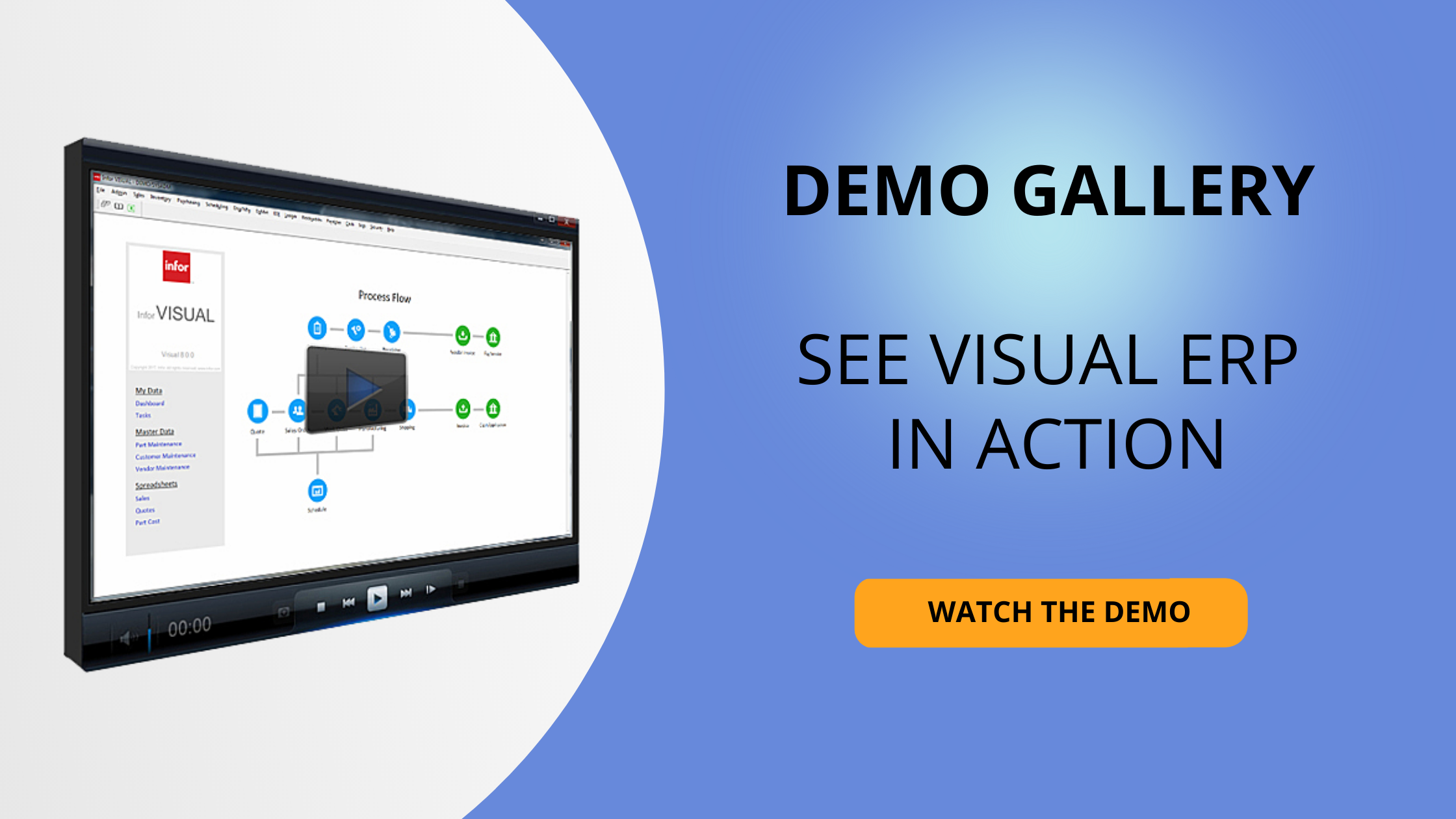
Planning for success
Material planning and scheduling are perhaps the two most difficult processes for any manufacturing company to perfect. While the processes generally live in two different departments, the success of one is highly dependent on the success of the other. In this article, we will discuss Visual South’s methodology for implementation of the Advanced Planning and Scheduling (APS) functionality in manufacturing. I will use Infor CloudSuite Industrial as the ERP software of reference.
Related: CloudSuite Industrial: Run at Maximum Efficiency
Material Planning
Let’s first consider the basic goals of a Material Planner. This is not a complete list, and it’s in no particular order, but rather a good starting point to keep things simple (this will be a recurring theme). A Material Planner needs to:
- Have all raw materials available to fulfill demand on time (job orders, customer orders, transfer orders, etc.)
- Keep proper safety stock levels to account for drop in, or emergency, orders
- Keep accurate perpetual inventory
- Maintain accurate lead times
- Maintain accurate vendor pricing
- Manage “not enough” inventory vs. “too much” inventory
- Get accurate information from production scheduler to be sure requirement dates have not changed
Scheduling
Now let’s look at what the basic goals are for a Production Scheduler. Again, keeping it simple and looking at the most common requirements, a Scheduler must:
- Align job order finish dates with customer delivery dates
- Manage capacity constraints (bottlenecks)
- Determine job priority run order
- Reduce/combine set-up time
- Determine any needs for overtime
- Manage utilization and efficiency of machine and labor resources
- Lie to customer service to pad manufacturing lead time (just keeping it real)
- Get accurate information from material planning to be sure scheduled operations have the required materials
Scheduling Options In Infor CloudSuite Industrial
Of course, any good ERP solution will have functionality to help with both material planning and scheduling. Most packages have specific methods for planning and scheduling. Infor CloudSuite Industrial has the ability to tailor the planning and scheduling process to meet the needs of just about any manufacturer. Let’s look at some of those options.
See Infor CloudSuite Industrial in action
See Infor VISUAL in Action
Material Requirements Planning (MRP)
MRP is a great tool for fairly simple material planning needs. It evaluates all current and future demand against an item, and compares it to all supply and expected supply. If it finds a shortage, it simply uses the lead time for the item and subtracts that number of days from the required need date. You would use the scheduling tool to plan the required dates needed by MRP.
MRP will plan a release date in the past if the required date minus the lead time is before the current day. For some companies, this is preferable because they may treat lead time more like buffer time and know they can possibly reduce it. Material requirements do not affect operation schedules in this scenario, since MRP is not constrained by the date of the current day.
Infinite Advanced Planning and Scheduling
Infor Advanced Planning and Scheduling comes in two different modes with the Infor CloudSuite Industrial ERP solution: Infinite and Finite. Infinite APS assumes that you have unlimited resources within a shift. It still limits the amount of work it can do, as defined at the operation level, to what is available for the resource and shift.
For example, if the total run time to complete a particular operation on a job is 10 hours and the resource is available for 8 hours on one shift, APS will schedule that operation to be completed over two days. APS assumes you can run an unlimited amount of 8 hour jobs on that resource, even if in reality it can only run one job at a time.
The benefit of Advanced Planning and Scheduling is that it does both scheduling and material requirements planning synchronously. At the same time it determines the scheduled start and stop times of the operations, it also creates the planned orders for the materials, aligning the required dates with the operation start dates. Regardless of infinite or finite, APS will always use the current day’s date as a hard stop and won’t plan a release prior to that.
Even with infinite capacity, if a required material for an operation has a lead time of 10 days—and there is no other supply available—the soonest the associated job operation can start is in 10 days. APS does a “pull” or “backward” schedule from the job due date to determine each operation start date. If the first operation start date is before the current day, it then performs a “push” or “forward” schedule. Material availability is a constraint in APS (unlike MRP), so an operation cannot be scheduled until APS determines a supply due date for any materials needed at the operation.
Infinite APS also provides the ability at sales order entry to quickly view an item’s Available to Promise (ATP) date. CloudSuite Industrial will look at an item’s bill of manufacture template and determine where it can fit in the schedule. It will then provide the option to either keep the order line’s due date or change it to APS’s suggested date. With Infinite APS, think of the projected date as a best-case scenario, since it basically gives the production planner or scheduler the ultimate choice of which jobs to run when a resource is scheduled over capacity. Best practices dictate that you pad the projected date a determined amount when possible.
Infinite APS works well for companies that really don’t have resource constraints. Or perhaps a company that does have some constraints, but flexible enough to increase capacity when necessary. This is more common when labor determines throughput, rather than machines.
Finite Advanced Planning and Scheduling
Finite APS is very much like Infinite APS, with one primary exception: It recognizes that a resource has finite capacity and cannot complete more work in a shift than the sum of the total available resources and shifts required by an operation.
For example, if you have two jobs with a total run time of 8 hours each and both need to go through the same resource at the same time, but only one resource exists on the shift, then it will take two days to complete both jobs (assuming one shift). Finite APS will not schedule both jobs to go through the resource at the same time like Infinite APS would.
Finite APS is also a little different for the order entry process. Instead of the ATP date that Infinite APS provides, Finite APS has a Capable to Promise (CTP) date. It provides the same option to accept or reject the calculated projected finish date, however it is using the finite capacity rules to determine a projected completion date. With CTP, think of the projected date as the worst-case scenario, since it is trying to load the item’s operations against an already loaded schedule. In essence, it is considered the lowest priority at the time you check the CTP date. In reality, it’s possible that this job may be sequenced at a higher priority when you run a full Advanced Planning and Scheduling process regeneration (usually nightly). It’s possible that it moves up in the schedule.
Finite APS works well for companies that are resource capacity constrained, and need more realistic control and scheduling of the constraints. This is more common when machines determine total run hours, as opposed to labor being the long pole.
Download the 6-step guide to successfully implement ERP
Which method is best?
There’s no best solution—it depends on your needs. CloudSuite Industrial has multiple options because companies have different scenarios that will call for one solution over another. However, if you currently do not use any of these planning options, it sometimes makes sense to start simple and work your way toward more complexity. (Or stop at simple if it works well enough for you.)
Also, the examples and descriptions I gave above are very basic. There are many other options, variables, and parameter settings that can be used to fine tune any of these three methods. If I were to make a general recommendation, I’d advise you use Finite APS and still have it treat some (or all) resources as infinite. I prefer to only finitely plan the resource determined to be the bottleneck, and infinitely plan all other resources. This allows you to manage the constraint without worrying about the resources you know aren’t a constraint. It’s more of a moving target, but CloudSuite makes is easy to change the finite resource to follow the new constraint.
Happy planning!








